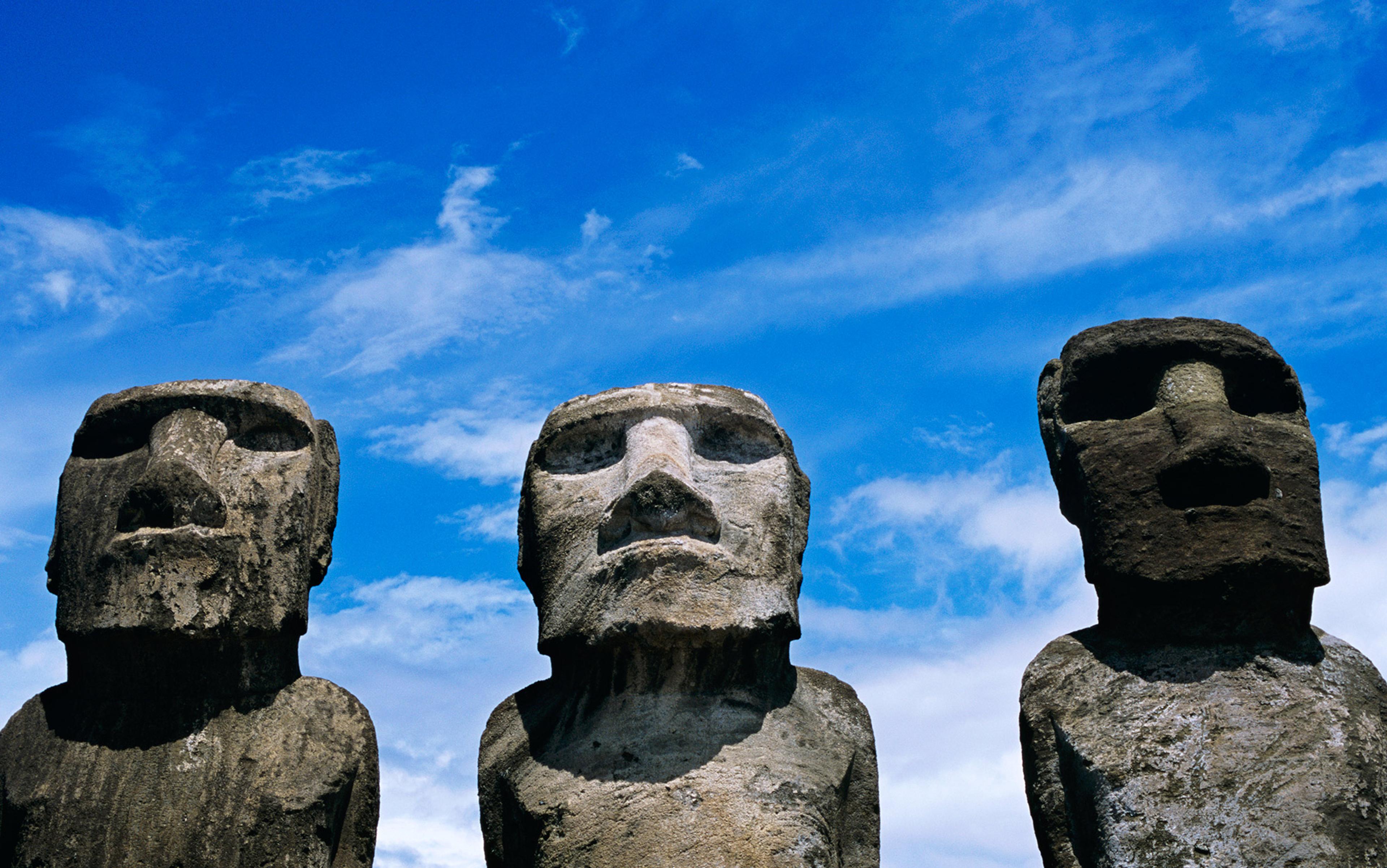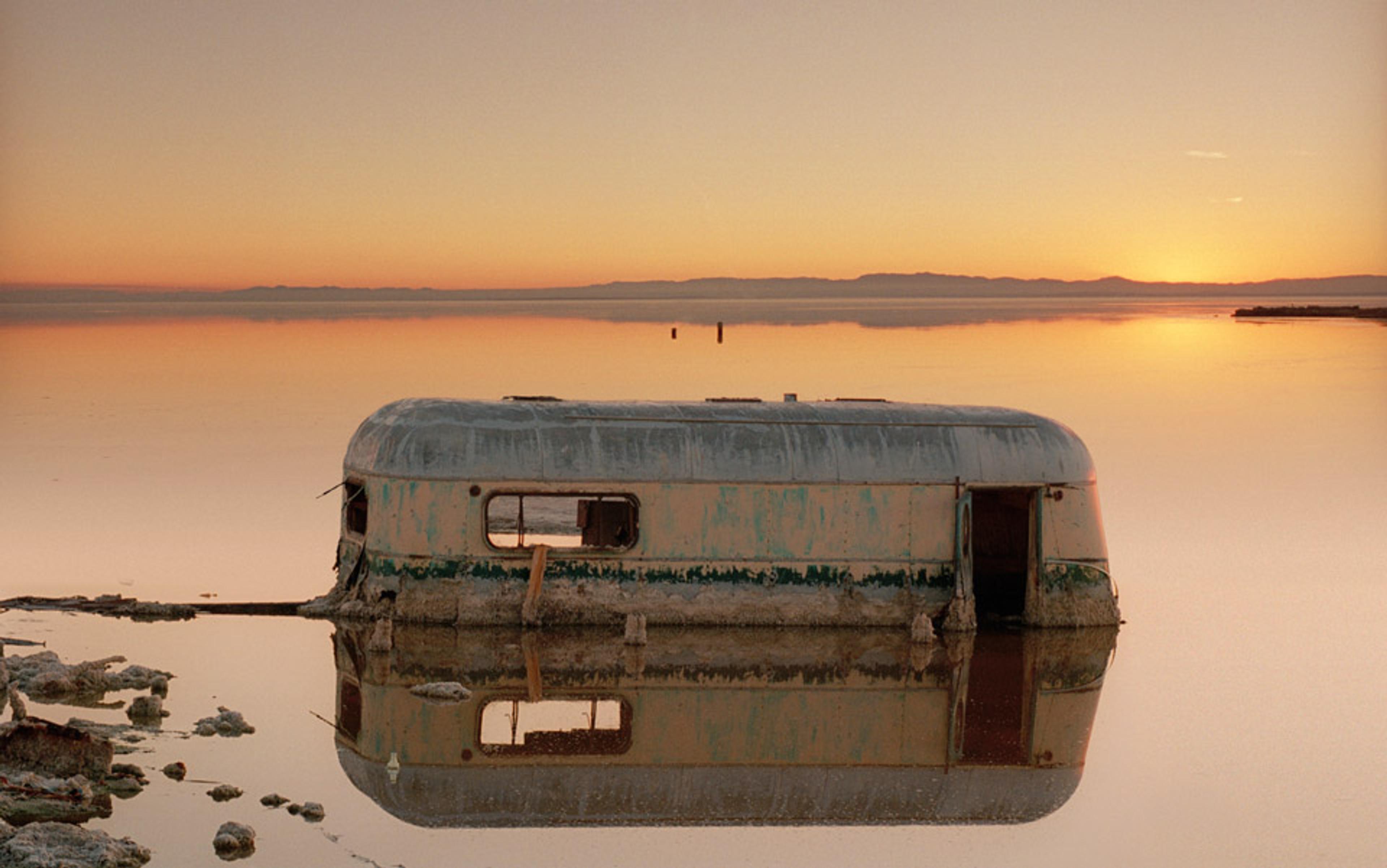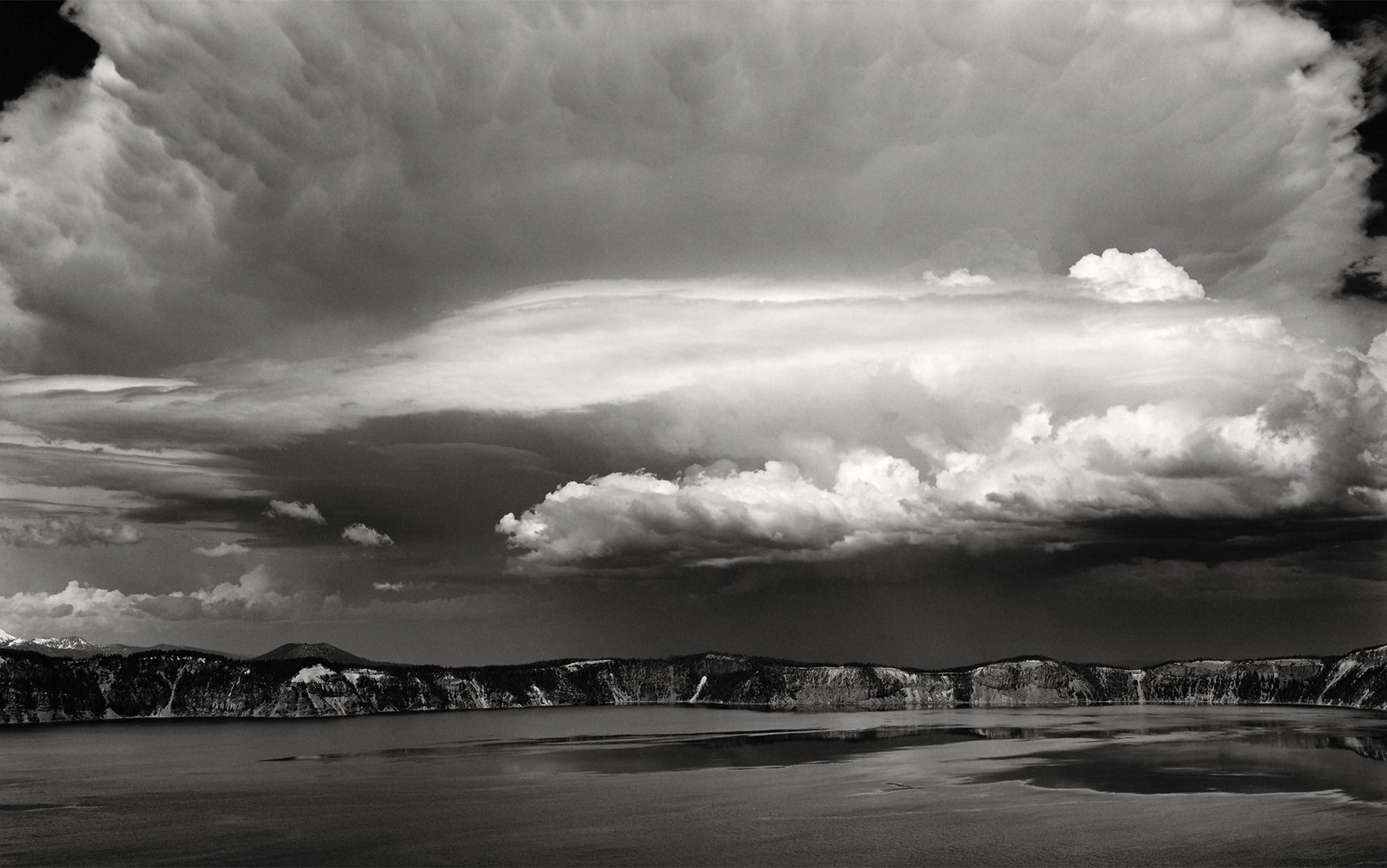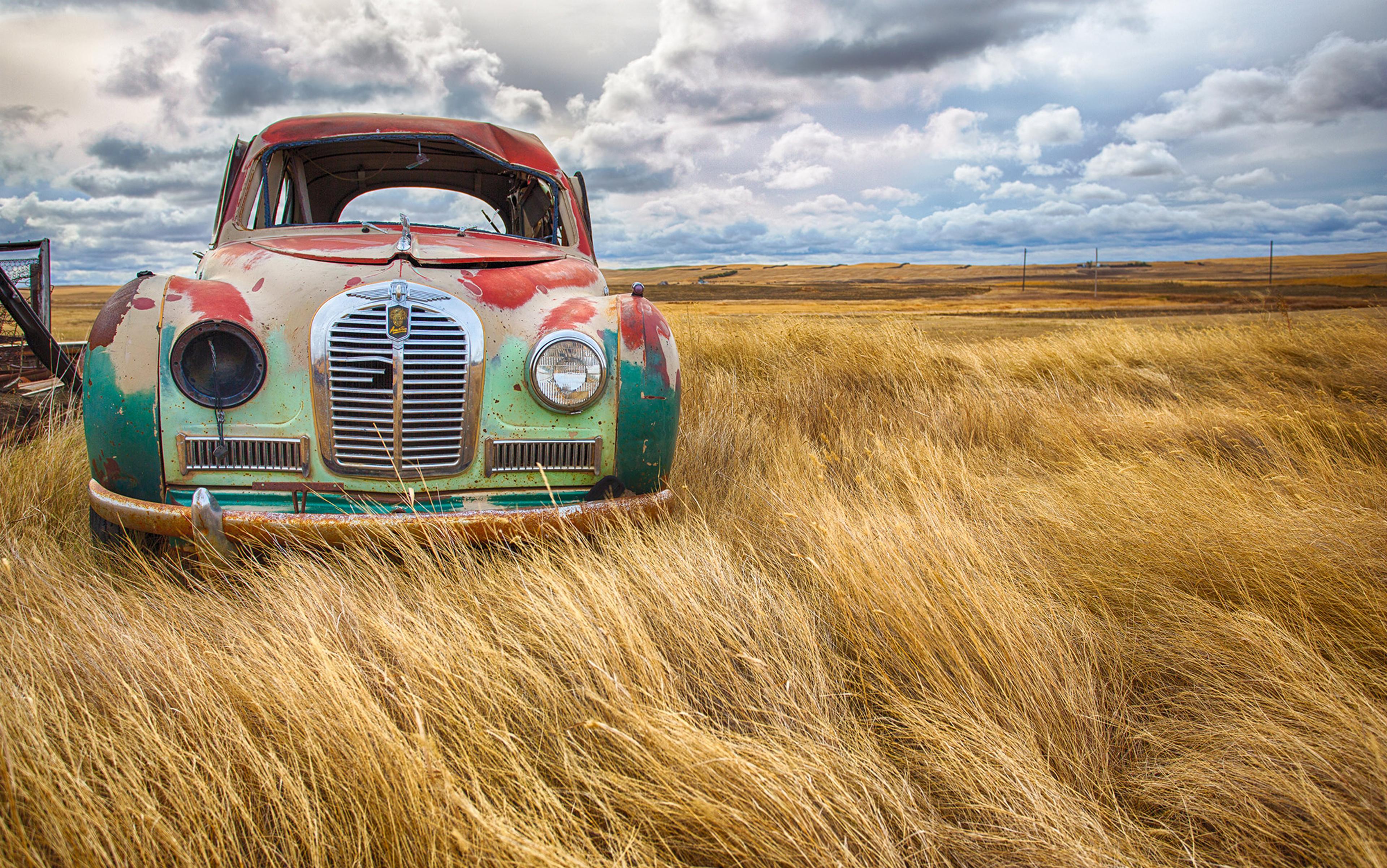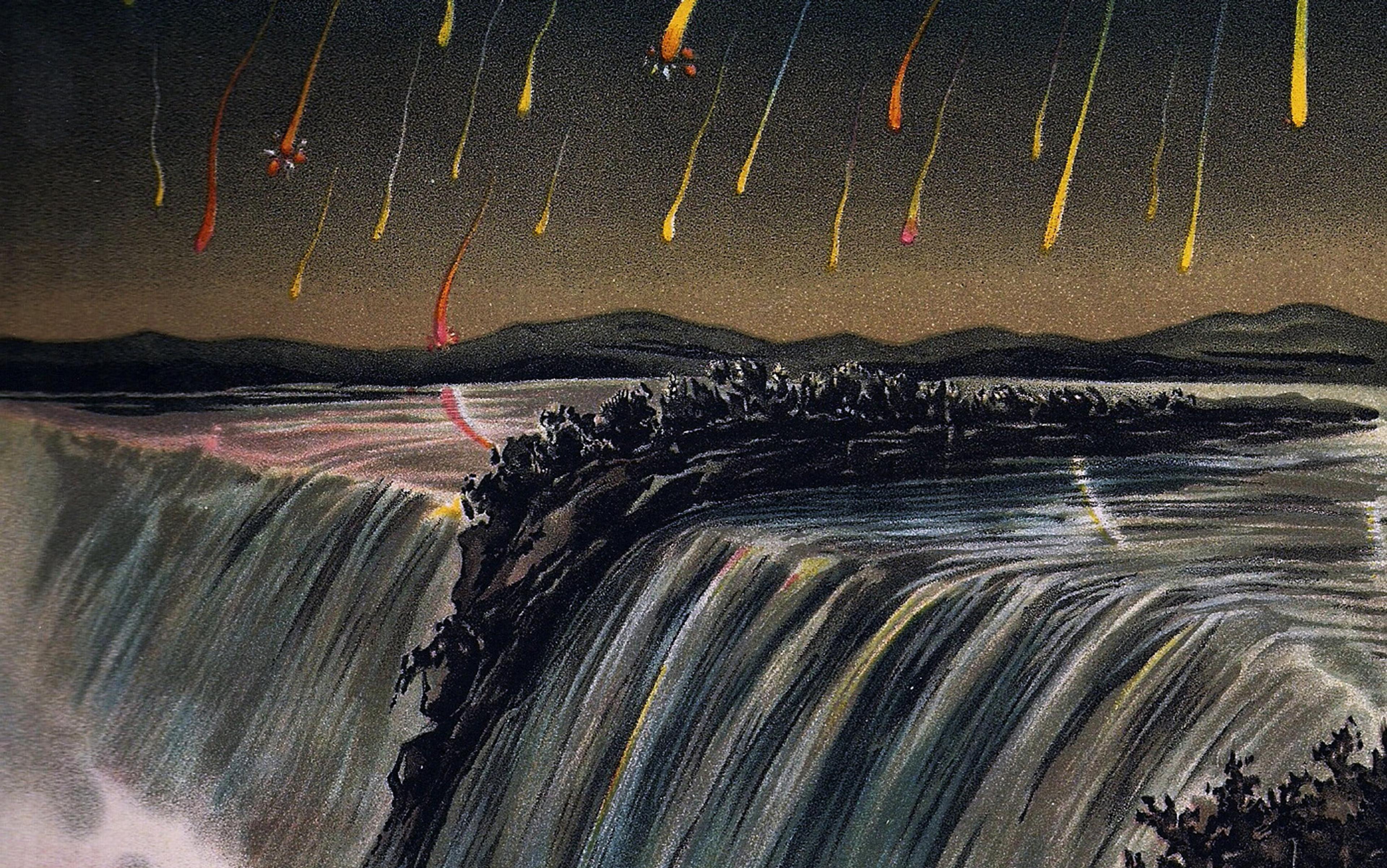There’s a common story of how the Maya civilisation was wiped out: they fell foul of unstoppable climate change. Several periods of extreme drought withered their crops and killed off thousands in their overpopulated cities. ‘There was nothing they could do or could have done. In the end, the food and water ran out – and they died,’ wrote Richardson Gill in 2007. The jungle reclaimed the cities with their palaces and pyramids until they were rediscovered in the 19th century by intrepid explorers.
Likewise, we all know that the Easter Islanders chopped down all the palm trees on their small, isolated island to clear farmland for their ever-growing population and to move their characteristic moai statues, not realising that they were eroding their landscape, reducing their food production, and ultimately cutting themselves off from the bounty of the sea – and the possibility of escape. The Europeans who found the island in the 18th century wondered how such primitive people could ever have had a civilisation developed enough to carve the majestic stone heads.
These stories come from frequent reports in the mass media, from luridly titled history documentaries such as the History Channel’s Who Killed the Maya? (2006) or the BBC’s Ancient Apocalypse: The Maya Collapse (2012-14), and especially from books on the environment and sustainability. Jared Diamond’s bestselling Collapse: How Societies Choose to Fail or Succeed (2005) is only one of many works that recount them – ensuring that they have reached an audience of millions. There are similar stories about many other past societies, whether it is the Puebloans of the southwestern United States, the Harappans of the Indus Valley, or the ancient Mesopotamians. It has even been claimed by some that climate change has been the major driver of collapse, and by others, such as Diamond, that deforestation and environmental damage have very often been to blame.
The stories are often presented as cautionary tales to frighten us into correcting the error of our ways – lest we bring about the end of our own global civilisation. They promote an ethic of environmental responsibility that we ignore at our peril. It is no coincidence that they focus on climate change, human-caused environmental impacts and overpopulation because these three factors are the major global concerns of our times. They have a strong appeal to us because of the ubiquity and antiquity of disaster-based stories. Daily, the media shows us images of both real and fictional disasters: earthquakes, famines, plagues, tsunamis and so on, and these are recycled into yet more fact and fiction in an ongoing process of cultural production and continuity. When we think of what a collapse would look like, a ready-made set of ideas and images comes to mind.
But are these stories right? Is that really what happened to the Maya and the Easter Islanders? In the view of many archaeologists, collapse is not quite so simple – the silver-bullet theories grow less convincing the closer they are scrutinised. As the eminent archaeologist Sir Mortimer Wheeler sagely pointed out in Civilisations of the Indus Valley and Beyond (1966): ‘The fall, like the rise of a civilisation is a highly complex operation which can only be distorted by oversimplification. It may be taken as axiomatic that there was no one cause of cultural collapse.’
Like jargon in any field, ‘collapse’ has specific meanings that can be misunderstood or taken out of context. Many archaeologists follow Colin Renfrew’s Approaches to Social Archaeology (1984) and Joseph Tainter’s The Collapse of Complex Societies (1988), which both see collapse as an abrupt political change and reduction in social complexity that has knock-on effects throughout society, visible to archaeologists in the material culture. If we think of complexity in terms of the ‘parts’ a particular society has, or the levels in its social hierarchy, we can visualise this kind of collapse easily.
In After Collapse (2006), Glenn Schwartz compiled a useful list of circumstances in which archaeologists might identify collapse: ‘the fragmentation of states into smaller political entities; the partial abandonment or complete desertion of urban centres, along with the loss or depletion of their centralising functions; the breakdown of regional economic systems; and the failure of civilisational ideologies’. For some non-archaeologists, such as Diamond, who approach collapse from an ecological perspective, collapse means primarily population collapse – the deaths of many people and, of course, significant cultural, political and social change. Archaeologists might also identify decreases in population, but this is not their primary characteristic of collapse.
Take the Mycenaean culture of Late Bronze Age Greece. Several states with central palaces developed by around 1400 BCE. At the heart of each palace was a distinctive building called a megaron. These throne rooms had large central hearths, surrounded by four columns, and a throne in the middle of the right-hand wall. They were usually decorated with elaborate frescos. Aegeanists link the development of kingship with the development of this architectural scheme – which is the material expression of a distinctive ideological system. We know that there were kings because some of the palaces kept selective records of goods and materials that came in and went out or were stored on clay tablets in the Linear B writing system; these mention a figure called the wanax, who could appoint people to positions, took part in ceremonies, and held the most land.
Around 1200 BCE, perhaps over a span of a few decades, the palaces were destroyed in fiery events – Mycenae, Tiryns, Pylos and others. Though there was rebuilding at some sites – most clearly visible at the major site of Tiryns, where a new palace was built over the earlier megaron’s foundations – it followed quite a different architectural form, without the hearth and four columns. Linear B fell out of use and, we surmise, the system it represented came to an end, or at least reduced in scale. The palace at Pylos, which had been the centre of a large territorial kingdom in Messenia, was abandoned. Around Greece, the number of visible sites drops considerably in this ‘Postpalatial period’ (though conspicuously not in the parts of Greece that had had no palace centres to begin with). There was no more building of impressive tholos (or beehive) tombs that the kings of Mycenae had built, of grand Mycenaean fortifications, or of public works such as bridges, harbours, and drainage. It seems clear that we can usefully term what happened in Mycenaean Greece around 1200 BCE as a collapse.
But there were continuities. Mycenaean pottery styles were retained and the tradition kept alive for another century and a half before other styles were developed. Religion endured: many Late Bronze Age gods, such as Zeus and Poseidon, were worshipped in historical times. It’s likely that the fall in the number of visible sites reflects the conflict and instability that started in the years before 1200 BCE and continued into the 12th century CE; rural sites might also have become generally smaller and less visible as the population came together at chosen sites. And as archaeologists know, sometimes there are just blank spots in the evidence – some periods and places where we know that people and societies are just very hard to detect. The Late Bronze Age Greeks did not suddenly disappear, although a drop in population over time is likely.
The continued occupation and expansion of Mycenaean sites suggests there were no problems with subsistence
What is significant is that the palace-based ideology ended, and some of its symbolism was deliberately rejected. Mycenaeans could have kept Linear B writing, or megaron suites, but did not. The term wanax for king was at some point replaced by the word basileus, which in Mycenaean times had no grand associations. Whoever was in charge after 1200 BCE wanted to do things differently – and perhaps they were in no position to reimpose the kind of authority that had existed earlier. And the collapse would have been felt more or less keenly depending upon one’s social position. For small-scale farmers, perhaps there was little change, save for an end to the palace-sponsored feasts and building projects, and the occasional requirement to send resources to the palace would have ended.
Some would like to blame the Mycenaean collapse on climate change or environmental damage in combination with overpopulation, which made the kingdoms’ continued subsistence precarious. But the evidence for this is limited indeed and not at all unambiguous. There is, for example, no evidence that the population of Greece has ever been high enough to outstrip its resources – certainly not in the Late Bronze Age. There is also very little palaeoclimatic evidence from which to posit a destabilising megadrought around 1200 BCE, and none of it comes from the parts of Greece that collapsed. What we do have comes from core samples as far afield as the Adriatic and Israel. Only two sources are from Greece, one from Lake Voulkaria in west central Greece and the other from the eastern Aegean.
Given that conditions throughout Greece can vary considerably at any one time, let alone the variation across the eastern Mediterranean, or the sea as a whole, it is somewhat premature to claim a climate-induced collapse based on current evidence. There is active research currently underway in Greece, but even if we do find better evidence of climate change, how do we tie it to collapse in a satisfactory way – beyond the mere fact of coincidence? And while some scholars have imagined ‘relentless exploitation of the soils and … excessive wood-cutting’ by the palaces, others see no trace of agricultural problems or food supply in either the archaeology or textual record. In the Argolid, on the eastern Peloponnese, where such impacts might be expected to have been the greatest, the continued occupation of sites and even expansion at Tiryns suggest that there were no problems with subsistence.
We also need to think about what we apply the term ‘collapse’ to – what exactly was it that collapsed? Very often, it’s suggested that civilisations collapse, but this isn’t quite right. It is more accurate to say that states collapse. States are tangible, identifiable ‘units’ whereas civilisation is a more slippery term referring broadly to sets of traditions. Many historians, including Arnold Toynbee, author of the 12-volume A Study of History (1934-61), have defined and tried to identify ‘civilisations’, but they often come up with different ideas and different numbers. But we have seen that while Mycenaean states collapsed, several strands of Mycenaean material and non-material culture survived – so it would seem wrong to say that their ‘civilisation’ collapsed. Likewise, if we think of Egyptian or Greek or Roman ‘civilisation’, none of these collapsed – they transformed as circumstances and values changed. We might think of each civilisation in a particular way, defined by a particular type of architecture or art or literature – pyramids, temples, amphitheatres, for example – but this reflects our own values and interests.
It is the same with the Maya and with the Easter Islanders. In both cases, civilisation and state have been confused and conflated. The Maya world was spread across a huge area with many different environments, from the dry northern Yucatán Peninsula to the river-fed lowlands in the south, and beyond into the mountains. It was an old and interconnected world of cities and kings, divided up among super-states of wide influence and more modest kingdoms that could fall under their spell. There were probably 60 to 70 ‘independent’ states; the fortunes of all waxed and waned. It was a bigger and more complex world than Late Bronze Age Greece.
With the Maya, we should be seeing a series of state collapses, over a period of around three centuries (the so-called Terminal Classic period, 750-1050 CE), not rapid, singular civilisational collapse. States within the Maya culture zone collapsed (though not all did) and, again, the specific parts of culture associated with the divine-king ideology were rejected – and that meant a change to material culture. The Maya specialists James Aimers at State University of New York and Gyles Iannone at Trent University in Canada recently suggested that we should see collapse as a stage ‘that occurs at different times in different places’ across the Maya world.
Sometimes, it is very clear what happened in a specific collapse, as at Cancuén, in the Pasión river region of the southern Maya lowlands. Around 800 CE, there was a fierce battle in the city – one the defenders had little time to prepare for. Palisades of wood and stone had been started but not finished. Spearheads were found across the site while human remains had signs of injury from spears and axes. The battle was lost, and the city’s rulers and elite were massacred and dumped in cisterns together with their regalia. King Kan Maax and (presumably) his wife were buried in shallow graves nearby. The city’s grand buildings and monuments were systematically defaced or destroyed, and the city was abandoned.
The Maya did not disappear, though cities were abandoned, the population fell and life changed
This story, gleaned from the archaeological evidence at Cancuén, tells us about an individual rapid collapse – the violent end of one Maya state and its elite class. It was undoubtedly terrifying and traumatic for the defeated. It came at the hands of an unidentified enemy, which the anthropologist David Freidel at Washington University in St Louis says ‘might have been a nobles’ revolt, a peasants’ revolt or an outside attack … We just don’t know.’ We can only guess at the motivation for the attack.
The Maya did not disappear, though cities were abandoned and, over time, the population fell and aspects of Classic Maya life changed – the rule of the mighty holy lords, the k’uhul ajaw, was rejected. They were still there, living in a complex society, when the Spanish arrived in the 16th century. Cities and trade remained, and the Maya collected their wisdom in books. During and after the period of the collapses, new cities were founded (or refounded) – Chichen Itza, Mayapan, and Uxmal in the dry northern Yucatán, and rivalries between noble families continued. Periodically, cities would be abandoned by elite groups or sometimes by the whole population. This happened for several reasons – infighting and political intrigue, famine and plague. At Mayapan, we know from historical records, the noble Xiu clan massacred their Cocom rivals, usually cited as the reason for its abandonment in 1441-1461 CE, but the city might have suffered endemic violence for two centuries before this. Perhaps Cancuén and other Classic Maya cities had similar problems that led eventually to their collapse and abandonment.
Almost nine centuries after the massacre at Cancuén, in 1697 CE, the armies of the Spanish destroyed the last independent Maya kingdom – the kingdom of the Itzas, based at the island city of Nojpetén. As Christians, they destroyed the pagan ‘idols’ that they found but they did not kill the royal family. Nojpetén’s last king, Ajaw Kan Ek’, was captured and baptised and renamed Joseph Pablo; he learned Spanish, and ended up living in the colonial town of Santiago de Guatemala. And it was the Christian Spanish who sought to destroy the ancient Maya culture – thousands of Maya books were burnt (only four remain today), and Maya families were broken up with children forcibly re-educated. Even so, millions of Maya descendants live in central America today.
The idea of a collapse of Maya civilisation seems just wrong – and it carries with it the wrong kind of implications – that the Maya all disappeared or that their post-collapse culture is less important or less worthy of our attention. Via many individual collapses, Classic Maya society transformed through the Terminal Classic and into the Postclassic – a development that is hardly surprising when compared with the changing map of Europe across any five-century period. Maya society continued to change with the arrival of the Spanish, and through the colonial and modern eras. If we value the Maya’s so-called Classic period more than their culture at other times, this is our choice – but it is one that should be recognised and questioned.
Easter Island, one of Western culture’s favourite tales of collapse, is now routinely used as a story of eco-disaster and a warning to all of the dangers of mistreating the global environment. It is a story about eco-collapse that caused population collapse that finally brought about political and social collapse. The moai, so central to the islanders’ lives, could no longer be moved, so they were abandoned – some even left unfinished in the quarry at Rano Raraku – and toppled. A new religion, the Birdman cult, took over. Thousands died. What survived was an impoverished and ignorant society of maybe 2,000 people eking out a squalid living, eating rats among the glories of their former civilisation.
Value judgments about, and characterisations of, the lifestyle of the islanders are wholly subjective. The early visitors had different opinions and gave mixed reports of what they found. The Dutch explorer Jacob Roggeveen in 1722 said that ‘they brought a great abundance of sugar cane, fowls, yams, and bananas’ and that there were large fish, crabs and shellfish, rats and plenty of fresh water. He thought the land very fertile, because of its volcanic origin. Other reports, it is true, were less positive, but no doubt the island’s fortunes fluctuated and visitors came in good or bad years.
The islanders had developed an effective agricultural and subsistence strategy. They used walled gardens called manavai that provided shelter from the wind and increased moisture, a technique called lithic mulching, where stones and pebbles are used in the soil to prevent erosion and increase temperature. Archaeology has revealed a number of such ‘farms’, located both near the coast and in the uplands. Eating rats was another rational strategy. Though we might find it distasteful, this is just a cultural sensibility – the Romans ate dormice, another rodent, but we do not react with disgust at this habit or think of Romans as particularly primitive.
‘It is a sad fact that in these [Easter] islands … wherever the white man establishes himself the aborigines perish’
The boat technology of the islanders also seems to have been well-adapted to the resources available. It is true that they could not build massive dug-out canoes – but this might have always been the case; such canoes were not built from palm wood. Instead the islanders used small pieces of wood glued or stitched together to construct canoes of up to 3 or 4 metres in length, capable of carrying several people several kilometres out to sea. The canoes might have been, as visitors pointed out, leaky and in need of constant bailing, but they worked. Recorded in a number of visitors’ reports from 1722 to 1870, and with no reason to doubt that such boats were built earlier, it’s evident that this was a long-lived and practical tradition.
Pre-contact Easter Island culture did change (why should it not have?), but that it collapsed in any sense, population- or culture-wise, is unclear. On balance, it seems unlikely that there was ever a unified complex state on the island that could collapse – there were chiefs in later times. The Easter Island expert Terry Hunt sees no evidence that the population of the island ever grew higher than around 4,000 individuals – a level that is far from unsustainable. The evidence for a pre-contact population collapse, a key part of the eco-disaster model, is far from conclusive. The moai carving did stop, but the existing moai remained important for around a century; this is demonstrated by the trouble taken by enemies to topple them, ritually ‘killing’ them and removing their power. Most statues were upright in 1722, but by 1744 some had been toppled. Sixty years later, 20 still stood, by 1830 there were eight; in 1868 no moai remained upright. In other words, the moai culture was still ‘live’ in the period to which collapse is usually assigned – around 1680 CE – and after.
The real problem that Easter Islanders faced was not any climate change or ecocidal destruction of their own environment, it was not that their way of life was unsustainable – it was, once again, outsiders who brought disaster and change. With them came animals, disease and Christianity. As with the Maya, the local culture was targeted for destruction. The population was drastically reduced by slave raiding. From 1862-63, many islanders were kidnapped and put to work in Peru or in the guano mines of the Chincha Islands. There might have been as few as 750 islanders left by 1864. If there was any collapse, this was it. As H V Barclay, the captain of the HMS Topaze, said in 1868: ‘It is a sad fact that in these islands, as in North America, wherever the white man establishes himself the aborigines perish.’
Why are ‘apocalyptic’ stories of civilisational collapse so appealing in contrast with the more complex and nuanced narratives tentatively suggested by many archaeologists? At least since the early 20th century, we have been looking forward to the end, on a global scale. Spanning popular and academic culture, the father of modern futurology, H G Wells, announced in a 1902 lecture to the Royal Institution in London that:
It is impossible to show why certain things should not utterly destroy and end the human race and story; why night should not presently come down and make all our dreams and efforts vain … something from space, or pestilence, or some great disease of the atmosphere, some trailing cometary poison, some great emanation of vapour from the interior of the Earth, or new animals to prey on us, or some drug or wrecking madness in the mind of man.
Stories of mass destruction, societal breakdown and civilisational collapse run deep in our culture, from Sodom and Gomorrah, destroyed by a wrathful god, to the destruction of Atlantis, submerged under the sea after a massive earthquake. No matter whether literally true or not, these remain two of the most well-known stories in our society – dramatic and vivid, easy to imagine and see. The destruction of Pompeii has captivated audiences for centuries, spawning theatrical reconstructions known as ‘volcano entertainments’, replete with dancers, fireworks and an erupting volcano, novels such as Sir Edward Bulwer-Lytton’s bestselling novel The Last Days of Pompeii (1834), and feature films and documentaries, in addition to the many popular and scholarly books.
In literature and film, too, there have been so many contributions that have shaped and continue to shape the ongoing discourse of collapse – in apocalyptic fiction we can trace a line from Mary Shelley’s The Last Man (1826) and Jack London’s The Scarlet Plague (1912) to the more recent contributions of Margaret Atwood’s Oryx and Crake (2003), Cormac McCarthy’s The Road (2006) and Sarah Hall’s The Carhullan Army (2007), among many others. In film, apocalyptic, post-apocalyptic and general disaster movies are a favourite genre – often dwelling on current concerns such as cometary impact or climate change – Armageddon (1998), 2012 (2009), The Day After Tomorrow (2004), Contagion (2011), and San Andreas (2015) to mention a few. Such stories can have serious staying power: Richard Matheson’s novel I Am Legend (1954) has been made into three films across the decades. We are fascinated by the ‘what ifs’ of the end of our wider society, our institutions and way of life, about what would happen if some ‘mega-event’ took place – how would we act, what values would we have?
They appropriate the histories of past and indigenous peoples, and construct them as Western-focused parable
So we are primed by our cultural inheritance to see past collapses as apocalyptic events. As storytelling animals, tales of civilisational collapse are attractive – they have an internal consistency that gives them narrative logic. But there is also a psychological aspect to thinking about collapse past and present. Looking at past collapses, we can feel superior, technologically and morally, to earlier peoples and societies – we know why they failed and how we can succeed, our sense of progress is reinforced. There might be a tinge of schadenfreude even. Turning that to the possibility of near-future collapse, by imagining ourselves standing on the precipice of some epochal change, we make ourselves feel more important – we are living at a key time and we have the power to affect global civilisation, either positively or negatively.
The stories of the Maya and climate change, and the Easter Islanders’ ecocidal self-destruction, suit those who want to make a dramatic argument about our own mistreatment of the environment in modern times, and the possible fate of our own civilisation. They are dramatic, media-friendly, soundbite stories that convey moral and practical lessons, hence they are commonly found in environmental literature and the mass media. There has been a trend to explain other collapses in the same way. But such stories appropriate the histories of past and indigenous peoples, and construct them as modern Western-focused parables. They dwell on the supposed failures of pre-modern and non-Western societies rather than stressing their resilience in the face of difficulties or recalling the Western role in their eventual cultural destruction.
States collapsed, civilisations or cultures transformed; people lived through these times and employed their coping strategies – they selectively preserved aspects of their culture and rejected others. Archaeologists, historians and others have a duty to tell the stories of these people, even though the media might find them less satisfactory. And writers who appropriate history for moral purposes need to think carefully about what they are doing and what they are saying – they need to make an effort to get the history as right as possible, rather than dumbing it down to silver-bullet theories.
In The Travels of Persiles and Sigismund (1617), Miguel de Cervantes wrote: ‘Prudent men should judge of future events by what has taken place in the past and what is taking place in the present …’ Looking around us, we can see the trouble we are in, we can see the threats to our overpopulated world, to our overly complex and thus increasingly vulnerable society and way of life. We do not need to make other peoples’ histories into lessons for ourselves. When the evidence for environmentally driven collapses in the past is so weak, and the evidence for contact-era atrocities so strong, it is a wonder that the former is the focus and the lesson, rather than the latter. Perhaps we should be asking ourselves what exactly we should be learning from history.
